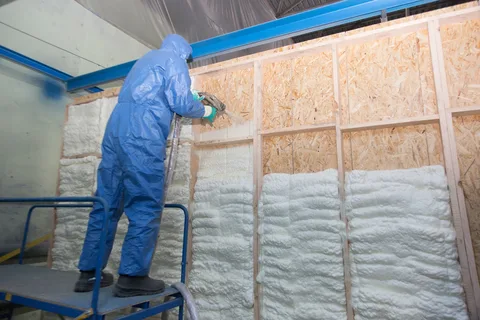Spray foam insulation is an effective way to enhance energy efficiency and comfort in homes and businesses. However, many DIY spray foam installers make mistakes that can lead to unsatisfactory results. Understanding these pitfalls is essential for achieving optimal insulation performance. This guide will explore common mistakes made by DIY spray foam installers and how to avoid them, ensuring your insulation project is a success.
Understanding Spray Foam Insulation
Before diving into the common mistakes, it’s important to grasp what spray foam insulation entails. This insulation type is created by mixing two components, which expand upon application. The result is a strong, air-tight seal that enhances insulation. It’s available in two primary forms: open-cell and closed-cell. Closed-cell spray foam offers a higher R-value and moisture resistance, making it a popular choice for various applications, including residential, commercial, and agricultural insulation.
The Dangers of Overconfidence
Ignoring the Need for Professional Guidance
Many DIY spray foam installers underestimate the complexity of the job. They may believe that they can figure it out on their own, but this approach often leads to mistakes. Without the guidance of a knowledgeable contractor, they may misinterpret instructions, leading to improper application and poor insulation performance.
Skipping Safety Precautions
Safety should never be an afterthought. DIY spray foam installers often overlook necessary safety precautions. The chemicals used in spray foam can be hazardous if not handled correctly. Without protective gear, they risk exposure to harmful fumes and skin irritation. It’s essential to wear appropriate safety equipment, including goggles, gloves, and masks, to ensure personal safety during the installation process.
Preparation: The Key to Success
Failing to Prepare the Area
One of the most significant mistakes is neglecting to prepare the installation area properly. DIY spray foam installers might think they can apply the foam without cleaning the surface. However, dust, dirt, and moisture can significantly impact adhesion. They should ensure the area is clean, dry, and free of debris before starting.
Underestimating Material Requirements
Another common oversight is misjudging the amount of spray foam needed for the job. This can result in running out of material halfway through the project or over-purchasing, leading to waste. By calculating the required volume accurately, DIY spray foam installers can save time and money while minimizing waste.
Technique Matters
Inconsistent Application
The application technique is crucial for achieving a successful insulation job. DIY foam installers often apply the foam too thickly or too thinly. Applying it too thickly can lead to bubbles and uneven surfaces, while applying it too thinly can result in insufficient insulation. A uniform application is key to ensuring optimal insulation performance.
Neglecting Temperature and Humidity
Temperature and humidity can significantly affect spray foam application. Many DIY installers overlook the recommended temperature ranges for application, leading to poor adhesion and expansion. They should check the weather conditions before starting the project to ensure optimal performance.
Post-Application Mistakes
Failing to Inspect the Work
After applying the spray foam, some DIY installers may not take the time to inspect their work. They might miss gaps or inconsistencies that can lead to air leaks. Conducting a thorough inspection allows them to identify and correct any issues before they become significant problems.
Not Allowing Proper Curing Time
Curing time is critical for spray foam insulation to reach its full effectiveness. Some DIY spray foam installers may rush through the process and not allow adequate time for the foam to cure. It’s important to follow the manufacturer’s guidelines for curing time to ensure optimal performance and safety.
FAQs
What is spray foam insulation?
Spray foam insulation is a type of insulation that expands upon application, creating an air-tight seal. It helps improve energy efficiency in homes and businesses.
How does closed-cell spray foam differ from open-cell spray foam?
Closed-cell spray foam has a higher R-value and offers better moisture resistance than open-cell spray foam, making it ideal for various applications, including residential and commercial insulation.
Can I apply spray foam insulation in any weather conditions?
No, temperature and humidity can affect the performance of spray foam. It’s best to check the weather conditions before starting your project to ensure optimal application.
What safety precautions should I take when applying spray foam?
Wear protective gear such as goggles, gloves, and masks to avoid exposure to harmful chemicals and fumes during the application process.
How can I ensure a successful spray foam insulation installation?
Prepare the area thoroughly, use the right application technique, and allow adequate curing time to ensure a successful insulation project.
Conclusion
Spray foam insulation can significantly improve energy efficiency and comfort in various settings. However, DIY spray foam installers must be aware of common mistakes that can undermine their efforts. By understanding the importance of proper preparation, technique, and safety precautions, they can avoid pitfalls and achieve successful insulation results. For those looking for professional assistance in Minnesota, Foam Worx Spray Insulation is ready to help. Contact them at (507) 407-6688 to ensure your insulation project meets the highest standards.
